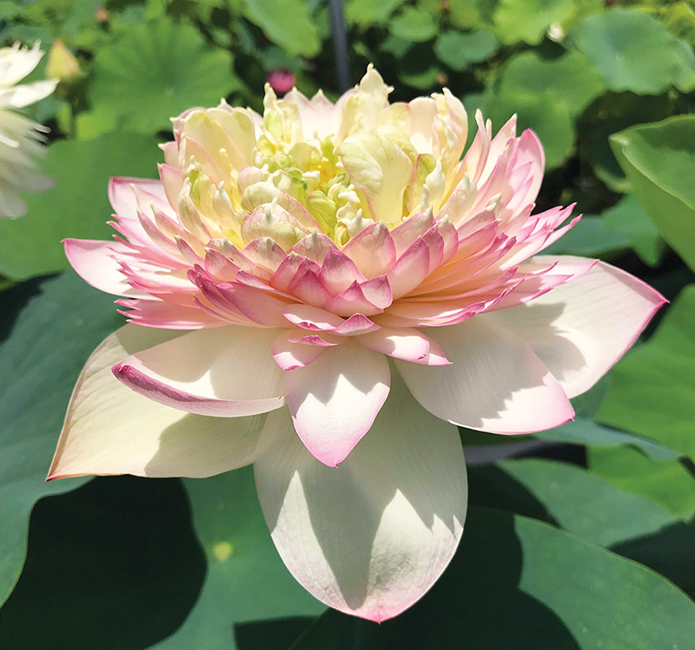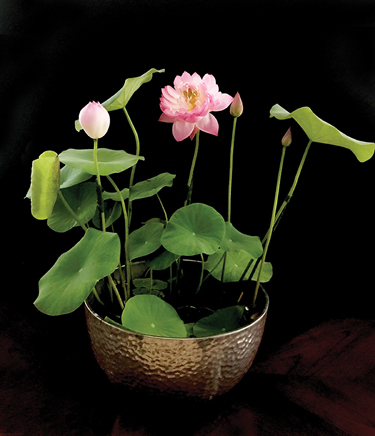
Ten Mile Creek Nursery had long specialized in general landscape plants, Gulf Coast natives and annuals — just your ordinary South Alabama nursery striving to survive in an uncertain economy. But on a warm afternoon in October 2009, we had our first encounter with growing lotus. We all met under the big pole barn. The nursery owner, Bill Bancroft, his parents, Laura and Steve Bancroft, Dr. Ken Tilt from Auburn University and two representatives from a Dutch company were hoping to introduce America to the possibility of growing water plants — specifically the sacred lotus, Nelumbo nucifera, in pots, on the patio and in their yards.
From that point onward, there has been no turning back. People all over the world have become fascinated with this beautiful plant and the idea that they do not need a pond or even an especially big space to enjoy its breathtaking beauty and grace.
The lotus is a symbol of purity, wisdom and peace and is a treasured plant steeped in ancient history. Likenesses of lotus leaves, flowers and seeds have been found engraved on bronze pots excavated in China dating back to the 10th century B.C. (the Broken Pot of the Minister of Jin Dynasty) and is often seen in Egyptian hieroglyphics from the pyramids.Delicate flowers in shades of red, pink, yellow and white are displayed on single stalks amid lush, round leaves of the deepest green, making the lotus one of the most spectacular plants in the aquatic environment. Their almost magical ability to roll away mud and dust allows them to present an ever-clean, fresh face for the world to see. This quality is known as “the lotus effect.” Their ability to self-regulate temperature within the flower allows them to survive even during the most stressful temperature extremes. Keeping the bud warm during cold nights and cool during hot days allows them to produce viable seeds.
Moreover, almost all parts of the lotus are edible at some point during the life cycle. Seeds and tubers are nutritious, high in anti-oxidants and delicious. Petals and green seedpods are used to make tea. Lotus have historically provided the treatment and cure for many ailments, and this is now being confirmed by scientific research.
Choose Wisely
 Lotus do not have a complicated list of requirements that are necessary to provide luxuriant growth and beautiful flowers. They just need good soil, lots of direct sunlight, very warm temperatures, regular fertilization and enough standing water to keep it from drying out. Lotus will not grow well inside except in greenhouse conditions and temperatures. They will not grow inside on your windowsill in a climate-controlled environment. They require five to seven hours of direct sunlight every day in order to thrive. They are quite easy to grow outside and will flourish almost everywhere in the United States.
Lotus do not have a complicated list of requirements that are necessary to provide luxuriant growth and beautiful flowers. They just need good soil, lots of direct sunlight, very warm temperatures, regular fertilization and enough standing water to keep it from drying out. Lotus will not grow well inside except in greenhouse conditions and temperatures. They will not grow inside on your windowsill in a climate-controlled environment. They require five to seven hours of direct sunlight every day in order to thrive. They are quite easy to grow outside and will flourish almost everywhere in the United States.
There are two types of Nelumbo nucifera: the hardy lotus, which are cyclical and go dormant in the winter, and the tropical lotus, which do not go fully dormant and grow most successfully in humid, tropical and subtropical climates. Lotus come in many colors and sizes with different types of flowers, so take it a step at a time when selecting the right lotus for you.
When choosing a size, ask yourself, “How much room do I have? How big do I want my lotus to be?” Lotus can be found in many sizes, from tiny Exquisite of Bowl Lotus (also called micro lotus) between 6 and 8 inches tall, to small or dwarf lotus (1 to 2 feet tall), to medium lotus (2 to 4 feet tall), to large/tall lotus (giant plants standing more than 4 feet tall).
As far as flower types go, you have another menu of choices. Flowers of less than 25 petals are called single or few-petalled; plants with 25 to 50 petals are semi-double; and flowers of more than 50 petals are double or multi-petalled. Duplicate flowers have carpels that are petaloid, with no seeds produced. Thousand-petal lotus have a significantly higher petal count than double-flowered lotus, with no receptacle.
Pot selection depends on plant size and whether you plan to place your pot into a pond where a darker-color pot will not be as visible through the water. They can be plastic, resin or glazed pots, as long as they are impermeable to water. Lotus prefer rounded pots with a wide surface area, shallow depth and no holes in the bottom of the pot. A growing lotus will coil around the bottom of the pot as it grows. If there are any holes in the bottom of the pot, your lotus will escape and begin filling up your pond.
For Exquisite of Bowl Lotus or micro lotus, the pot size can range from teacup size to 11 inches wide and 6 to 7 inches deep. The smaller varieties of micro lotus are easier to grow “pot-in-pot,” placing the smaller pot inside a wider and slightly deeper pot to lessen the frequency of watering. The smaller pot can be removed for display at any time. Pots should vary based on plant size for bowl lotus (12 to 14 inches wide and 7 to 8 inches deep), small/dwarf lotus (14 to 18 inches wide and 8 to 10 inches deep), medium lotus (16 to 20 inches wide and 10 to 14 inches deep) and large/tall lotus (at least 18 inches wide and at least 12 inches deep).
Note that the size of a lotus cultivar is a genetic trait; however, their final height is greatly affected by climate and cultivation practices. Lotus pots should be harvested and replanted every two to three years to keep the pot from becoming overcrowded, which results in smaller leaves and fewer flowers.
Planting Tips
Fill a pot half full of good topsoil (sandy loam) without a lot of organic matter or woody particles that will float. Patrick Nutt, the famous curator of the aquatic plants at Longwood Gardens, is quoted as having said, “If it grows grass, it will grow waterlilies and lotus.”

Add water to 1 inch above the soil. Well water is best, but tap water is fine. Make a slight indentation in the soil with your hand. Place the tuber into the indentation with the front-growing tip pointed toward the center of the pot. Be careful not to break the growing tips. Brush the soil over the top of the tuber to hold it in place, leaving the growing tips slightly above the top of the soil. Many people also prefer to leave the cut end of the tuber above ground. After three to four days, fill the pot to the top.
The average green growing cycle of a hardy lotus is approximately 140 to 150 days in a pot and slightly longer in earth-bottom ponds. When the plant is in full dormancy, there is no green vegetation above the water level. New tubers should be planted in the spring when the chance of freezing temperatures has passed and the nights have consistently warmed up to at least 50 degrees. Planting earlier will simply use up the energy stored in the tuber and could even delay or prevent your lotus from growing well.
How to Feed
Lotus are very heavy feeders, especially when the weather warms up and they are growing quickly. Begin to feed after an aerial leaf or three to five coin (floating) leaves are present, whichever happens first. Fertilize every three weeks using the schedule in the chart shown below. Notice that the dosage starts low, builds as the plant grows and then tapers as the growing season draws to an end. Proper fertilization will bring you dark green leaves and lots of flowers! Avoid fertilization after August 1.

Many people prefer to use a formula that is higher in phosphorus to encourage blooming. Waterlily World Tablets, Pondtabbs, Highland Rim and Landon Aquatic Fertilizer are all great products formulated especially for blooming aquatic plants. Follow the package instructions carefully.
Things to Remember
Here are some great tips by Dr. Daike Tian on fertilizing lotus. Vigorous and super-large-sized lotus need more food than smaller ones or cultivars with fewer leaves. Large containers need more food, but don’t calculate directly by multiplying. In other words, fertilizer should be much less than double in a 10-gallon container compared to a 5-gallon container.

The fertilization rate should increase as plants grow, and then should decrease a little bit beyond the growth peak. If your plants are not homogenous in size, especially in the early growth season, the application rate should be adjusted for safety. Decrease dosing for the weaker ones or those with fewer leaves. The application dose should also decrease a little bit if the water level is very low. Young flower buds are especially prone to damage from high concentration levels. If the leaves have inter-vein yellowing, a toxic level of fertilizer is possible. If the whole young leaf is yellow, it is overdosed seriously, so dilute the solution with water and stop fertilization for couple of weeks.
An abundance of additional information about lotus is available in books and on the internet. There is no one way to plant and grow these spectacular plants. The truth of the matter is that they are really very easy to grow — so just buy one and try it!



Very beautiful pink color lotus. I want to grow it in my garden.
How do i grow lotus from seeds?
Wow nice pink lotus.
Even I have planted lotus in small tank and few fishes I left in it…
Now a day buds are breaking, not understanding reason for this.